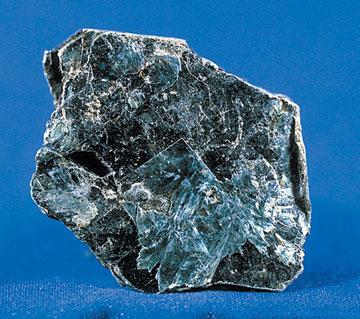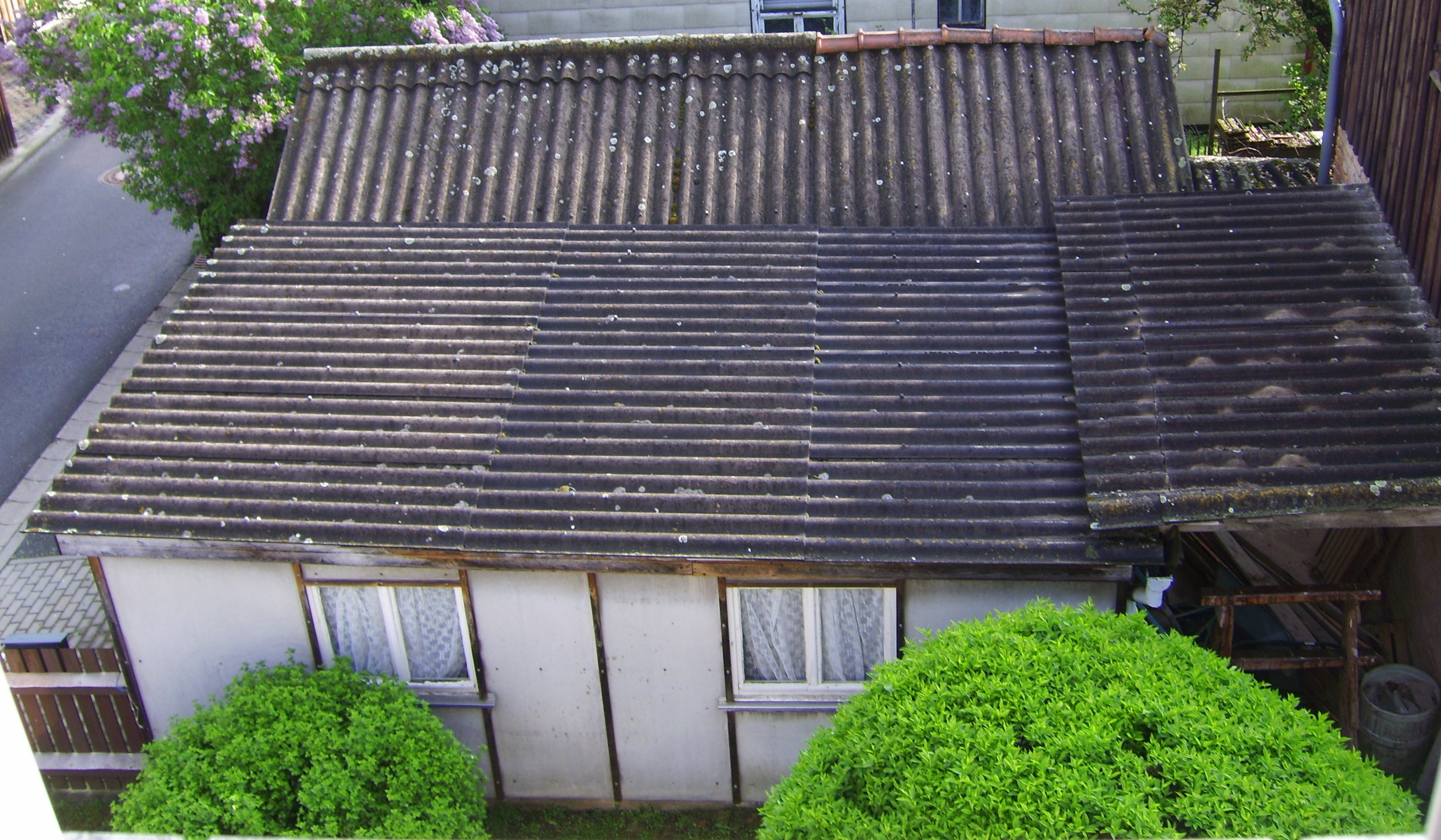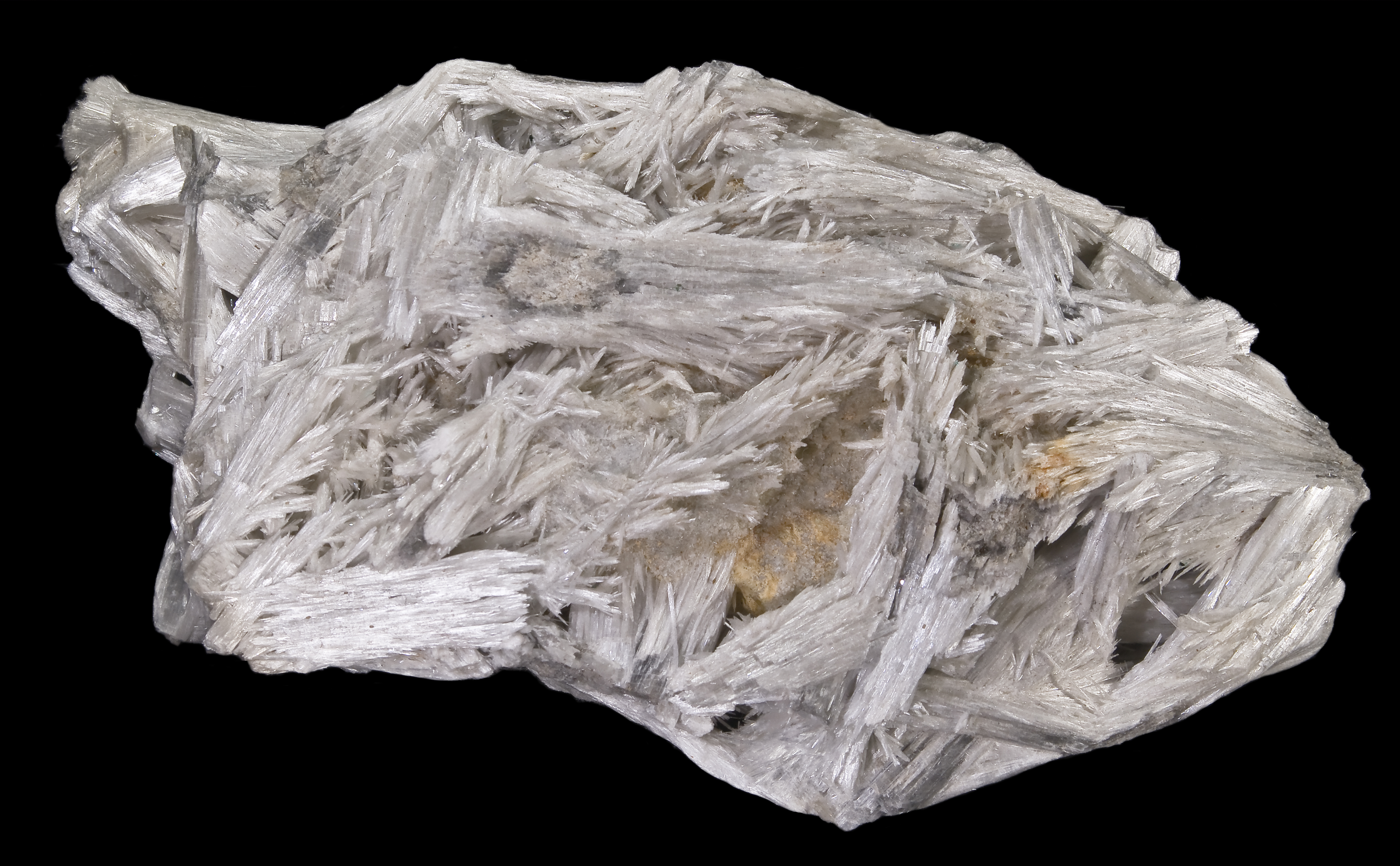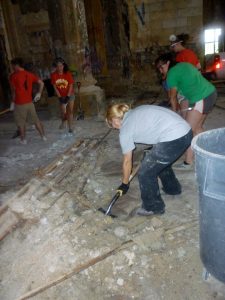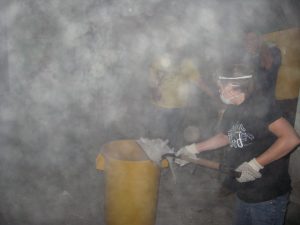Vermiculite, a hydrous phyllosilicate mineral, undergoes significant expansion when heated. Exfoliation occurs when the mineral is heated sufficiently, and commercial furnaces can routinely produce this effect. Vermiculite forms by the weathering or hydrothermal alteration of biotite or phlogopite.
Large commercial vermiculite mines currently exist in Russia, South Africa, China, and Brazil.
Vermiculite was first described in 1824 for an occurrence in Millbury, Massachusetts. Its name is from Latin vermiculare, to breed worms, for the manner in which it exfoliates when heated.
It typically occurs as an alteration product at the contact between felsic and mafic or ultramafic rocks such as pyroxenites and dunites. It also occurs in carbonatites and metamorphosed magnesium-rich limestone. Associated mineral phases include: corundum, apatite, serpentine, and talc. It occurs interlayered with chlorite, biotite and phlogopite.
Vermiculite is a 2:1 clay, meaning it has two tetrahedral sheets for every one octahedral sheet. It is a limited-expansion clay with a medium shrink-swell capacity. Vermiculite has a high cation-exchange capacity (CEC) at 100-150 meq/100 g. Vermiculite clays are weathered micas in which the potassium ions between the molecular sheets are replaced by magnesium and iron ions.
In 2014, South Africa, Brazil, the US, and China were the top producers of mined, concentrated and unexfoliated vermiculite, with about 90% world share. South Africa’s production is decreasing, while Brazil’s is significantly increasing.
While some end processors and exfoliators of vermiculite specialize, with proprietary products sold in a wide variety of industries, some have more varied end products, with less stringent technical requirements. Some vermiculite exfoliators blend with lower-cost perlite also. Vermiculite exfoliators have an international trade association called The Vermiculite Association to represent the industry’s interests and to exchange information.
Today spray-applied fireproofing materials use vermiculite, other industrial minerals, and expanded polystyrene, depending upon the exact commercial product. The ingredients for these products all have to meet stringent regulatory requirements, particularly in the US and Europe. In the past, vermiculite from the W. R. Grace mines in Montana, have been associated with asbestos. Therefore, old spray-applied fireproofing, pre-1991, may contain small quantities of asbestos. In August 2014, the NYSDoH qualified two, more exact, test methods, better designed to identify materials with this potential problem, and assist in safely dealing with any issues associated with its removal. Modern spray applied fireproofing today is made with vermiculite that does not contain asbestos and is carefully monitored at all stages of mining and production to ensure this is the case.
Although not all vermiculite contains asbestos, some products were made with vermiculite that contained asbestos until the early 1990s. Vermiculite mines throughout the world are now regularly tested for it and are supposed to sell products that contain no asbestos. The former vermiculite mine in Libby, Montana, did have tremolite asbestos as well as winchite and richterite (both fibrous amphiboles)—in fact, it was formed underground through essentially the same geologic processes as the contaminants.
Pure vermiculite does not contain asbestos and is non-toxic. Impure vermiculite may contain, apart from asbestos, also minor diopside or remnants of the precursor minerals biotite or phlogopite.
The largest and oldest vermiculite mine in the United States was started in the 1920s, at Libby, Montana, and the vermiculite was sold under the commercial name Zonolite. The Zonolite brand and the mine were acquired by the W. R. Grace and Company in 1963. Mining operations at the Libby site stopped in 1990 in response to asbestos contamination. While in operation, the Libby mine may have produced 80% of the world’s supply of vermiculite.
The United States government estimates that vermiculite was used in more than 35 million homes, but does not recommend its removal. Nevertheless, homes or structures containing vermiculite or vermiculite insulation dating from before the mid-1990s—and especially those known to contain the “Zonolite” brand—may contain asbestos, and therefore may be a health concern.
An article published in The Salt Lake Tribune on December 3, 2006, reported that vermiculite and Zonolite had been found to contain asbestos, which had led to cancers such as those found in asbestos-related cases. The article stated that there had been a cover-up by W. R. Grace and Company and others regarding the health risks associated with vermiculite and that several sites in the Salt Lake Valley had been remediated by the EPA when they were shown to be contaminated with asbestos. W. R. Grace and Company has vigorously denied these charges.
The vermiculite deposit at the mine in Libby, Montana, was (and is) heavily contaminated with asbestos. Numerous people were knowingly exposed to the harmful dust of vermiculite that contained asbestos. Unfortunately, the mine had been operating since the 1920s, and environmental and industrial controls were virtually non-existent until the mine was purchased by the W. R. Grace and Company in 1963. Yet, knowing the human health risks, the mining company still continued to operate there until 1990. Consequently, many of the former miners and residents of Libby have been affected and continue to suffer health problems. Over 400 people in the town have died from asbestos-related disease due to contamination from vermiculite mining from nearby Zonolite Mountain, where soil samples were found to be loaded with fibrous tremolite (known to be a very hazardous form of asbestos), and countless others there who insulated their homes with Zonolite have succumbed to asbestos-related diseases, most of whom never were employed in environments where asbestos was an issue.
After a 1999 Seattle Post-Intelligencer story claimed that asbestos-related disease was common in the town, the EPA, in response to political pressure, made cleanup of the site a priority and called Libby the worst case of community-wide exposure to a toxic substance in U.S. history. The EPA has spent $120 million in Superfund money on cleanup. In October 2006, W. R. Grace and Company tried to appeal the fines ($54.5 million) levied on them from the EPA, but the Supreme Court rejected the appeal. The United States government is also pursuing criminal charges against several former executives and managers of the mine for allegedly disregarding and covering up health risks to employees. They are also accused of obstructing the government’s cleanup efforts and wire fraud. To date, according to the indictment, approximately 1,200 residents of the Libby area have been identified as suffering from some kind of asbestos-related abnormality. Jury selection was to have been completed in February 2009. The case ended in acquittals on May 8, 2009. On June 17, 2009, the EPA issued a public health emergency in and near Libby, thereby allowing federal agencies to provide funding for health care, and for removal of contaminated insulation from affected homes.
Curated with thanks from Wikipedia.
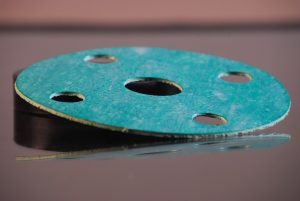 Asbestos is a natural mineral that can be harmful if you’re exposed to it. It’s a fibrous mineral that comes in different forms and is often found in various construction materials. The most common form is chrysotile, which has white or blue fibers. It’s also used in paint, plumbing, and sealants.
Asbestos is a natural mineral that can be harmful if you’re exposed to it. It’s a fibrous mineral that comes in different forms and is often found in various construction materials. The most common form is chrysotile, which has white or blue fibers. It’s also used in paint, plumbing, and sealants. Exposure to asbestos can result in the development of various types of cancer, including lung cancer, mesothelioma, and pleural effusion. Lung cancer is a deadly form of cancer caused by the abnormal growth of lung tissue. Asbestosis is a condition caused by the prolonged inhalation of asbestos fibers. Asbestosis causes breathing difficulties, chest pain, and coughing. Pleural effusions are fluid-filled sacs in the lungs and abdominal walls. Asbestos can cause any of these diseases, and this is why it is vital to avoid asbestos exposure.
Exposure to asbestos can result in the development of various types of cancer, including lung cancer, mesothelioma, and pleural effusion. Lung cancer is a deadly form of cancer caused by the abnormal growth of lung tissue. Asbestosis is a condition caused by the prolonged inhalation of asbestos fibers. Asbestosis causes breathing difficulties, chest pain, and coughing. Pleural effusions are fluid-filled sacs in the lungs and abdominal walls. Asbestos can cause any of these diseases, and this is why it is vital to avoid asbestos exposure.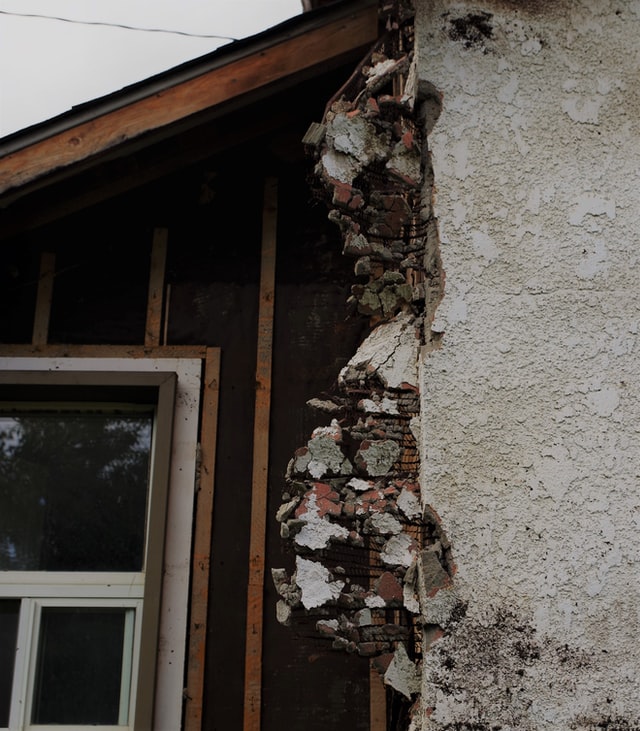 If you’ve worked around asbestos, you may be wondering what the dangers are. Exposure to asbestos can cause a wide variety of diseases, including mesothelioma. This deadly cancer affects the lining of your chest, abdomen, and lungs. Early warning signs include fluid buildup around the lungs, cough, and fatigue. As with all cancers, the most effective treatment for asbestos-related disease is prevention.
If you’ve worked around asbestos, you may be wondering what the dangers are. Exposure to asbestos can cause a wide variety of diseases, including mesothelioma. This deadly cancer affects the lining of your chest, abdomen, and lungs. Early warning signs include fluid buildup around the lungs, cough, and fatigue. As with all cancers, the most effective treatment for asbestos-related disease is prevention.